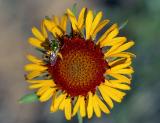 © Mike Norton (Colorado)
© Mike Norton (Colorado)

Ecosystems 101 for Colorado
What is an ecosystem?
Ecological systems are dynamic assemblages or complexes of plant and/or animal communities that 1) occur together on the landscape; 2) are tied together by similar ecological processes, underlying abiotic environmental factors or gradients; and 3) form a readily identifiable unit on the ground. Terrestrial ecological systems occur on the landscape at intermediate geographic scales of 10s to 1,000s of hectares and persist for 50 or more years. Systems are shaped by ecological processes that include natural disturbances such as fire, erosion, and flooding. The pattern and distribution of systems may be dependent on a variety of soil surface and bedrock features, or other environmental gradients including local climate and precipitation, area hydrology, and elevation.
Methods of Classifying Ecological Systems
Colorado’s ecosystems are described by various classification systems that differ depending on scale and purpose. For example, the classification system developed by the Denver Museum of Natural history identifies only 8 vegetation types for the entire state. At the other end of the spectrum, the National Vegetation Classification recognizes over 500 ecological plant associations for Colorado, making fine floristic and location distinctions such as West slope needle-and-thread grass versus East slope needle-and-thread grass plant associations.
The most commonly used ecosystem classification systems for Colorado are described below. Ecological system descriptions and viability guidelines are available for many of the systems in Colorado. These descriptions and guidelines are based on materials compiled by NatureServe or developed by the Colorado Natural Heritage Program. For more information on Colorado Ecological Systems visit CNHP's Ecological Systems page.
Colorado Natural Heritage Program Natural Plant Association Classification
A plant association is determined by species composition, structure and habitat. The CNHP classification recognizes nearly 600 plant associations. The CNHP Natural Community classification is widely used in Colorado. CNHP tracks the locations of high quality examples of natural communities in the state. This information is used by agencies and organizations such as The Nature Conservancy for conservation planning and prioritization. In addition, state land managers use this system to identify the habitats on their lands and to guide land management practices.
View a complete list of Colorado’s plant associations with imperilment ranks.
For a detailed description of wetland and riparian classification see the Field Guide to Wetland and Riparian Plant Associations of Colorado.
The U.S. National Vegetation Classification (USNVC)
The USNVC is an ecological classification developed by NatureServe and its natural heritage member programs in partnership with the Federal Geographic Data Committee Vegetation Subcommittee (FGDC), the Ecological Society of America Vegetation Classification Panel and federal partners. The USNVC is a seven-level hierarchical system consisting of Ecological Systems at the highest level and Plant Associations at the finest level.
Why focus on ecosystems?
The use of ecological systems in conservation planning is intended to identify major native ecological systems that, if conserved/managed at appropriate scales, would protect the majority of the plants, animals, and natural communities associated with them. A key assumption of this approach is that most native species can be maintained in viable numbers within native habitats at a landscape scale. Those exceptional species that either tolerate or specialize in habitats affected by alteration or conversion of native habitats may need individual conservation attention.
Visit LandScope America's ecosystems page.






